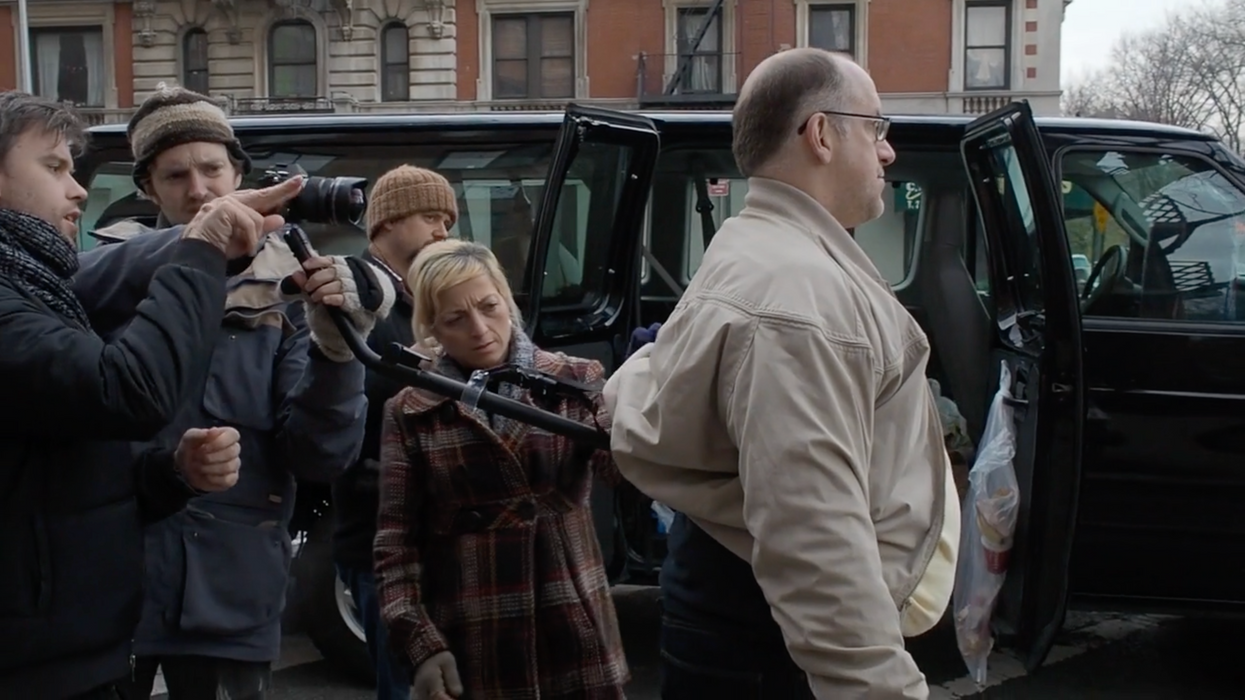When Your Actor is Your Camera Mount: BTS on 'The Irrational Fear of Nothing'
The frenetic, disorienting movements of the Snorricam render it a great tool for portraying deranged characters—even on a shoestring budget.

In Darren Aronofsky's Requiem for a Dream, DP Matthew Libatique strapped us to a psychotic Ellen Burstyn as she overdosed on speed. With the camera pointed right in her face (far past the "too close for comfort" threshold), we went deep into the recesses of her manic delusions. That stomach-lurching point of view granted us unique access to Burstyn's inner turmoil, and it was all made possible thanks to the Snorricam.
Now, Paul Trillo and DP Ed David have another entry for the Snorricam history books. Their short The Irrational Fear of Nothing straps us to the back of a neurotic man as he roams New York City in a paranoid mania. The experience is akin to getting a piggy-back from a man on the brink of an anxiety attack.
"The world rotates around him as he remains center in the frame," David told No Film School. The effect is somewhat of a stop-motion puppet feel. (In fact, the film bears many similarities to Charlie Kaufman's Anomalisa.) Reality feels warped; perspective is difficult to discern. In one shot, the main character rides an escalator. Much like being on an airplane during an especially sharp turn, it's hard to tell which way is up.
As would only be the case in New York, no one bothered the crew as they traversed the city and its subways with their unique rig. "Everyone is so myopic that they didn't even realize this bizarre contraption hanging off of this man," said Trillo. "That sort of reinforced the theme to me: that each individual's thoughts are worldview, no matter how inane they may be. That is all that matters to that person."
To build the rig, Trillo and David ultimately settled on the Sail Video System 3rd Person View camera mount because it afforded them the maximum amount of flexibility. They shot on an Olympus OMD EM5 II. "When you add a Snorricam, the weight is tripled, so the actor's basically wearing a 15-lb. rig," David said. "I like working with small cameras, because you can do weird and interesting things with them that you can't with heavier cameras."
"The physical stress [Michael Puzzo's] rib cage went through to wear that harness is nothing to envy and borders on war crimes," added Trillo. "I cannot say enough about how good of a sport he was."
"I'm getting spoiled with the Alexa and Red and Sony F65. You can screw up. With this camera, you either get it or you don't as you shoot."
"We placed the camera at a distance with the lens set to 9mm with a 4/3 sensor," David said. But keeping the camera in the same frame throughout the shoot was more difficult than David had imagined. "Paul drew an 'onion skin' on the monitors — a reference to the center point that marked the frame — and I had it on my monitor, too."
As the actor moved, the camera would move slightly, so the team had to figure out a way to combat the shake. "We didn't want the viewer to throw up," said David. The solution was somewhat improvisatory: They enabled the camera's internal Steadicam and manually held the camera when things got too shaky."The biggest challenge for me," said David, "was using a camera in a narrative setting that had several challenges: its native ISO is around 200 and its dynamic range was only about 11-12 stops. In essence, it was noisy and there was not much room for shadows or highlights. It isn't like most cinema cameras I work with."
"So for scenes that we lit — the audition scene, the diner, his bedroom — it was a challenge to make them feel natural. We also were flying through setups. The only scene that was more controlled was his bedroom, where we had time to light. The other setups were 2 Astra Litepanels 1x1 and a Dedolight 200w HMI light."
Limitations forced David to think more critically about the tools he was using. "I'm getting spoiled with the Alexa and Red and Sony F65," he said. "You can screw up. You can underexpose and bring things up; you can overexpose and recover data. Shooting raw, you can change white balance after the fact. You can control the exposure on the skin tones and you can add power windows. You have so many safety nets. With this camera, you either get it or you don't as you shoot it."
But for all the novelty of the Snorricam, both Trillo and David caution against gimmickry. "When you're using a specific technique," said David, "think about how it relates to the story and hopefully how it elevates the story." Trillo also emphasized the importance of story over equipment. "I was interested in how the technique lends itself to telling a very specific type of story," he said. "A story that wouldn't be as strong if it was told any other way. For me, that's the key. Once I unlock what narrative that best suits the visual, then I feel like I have something."











